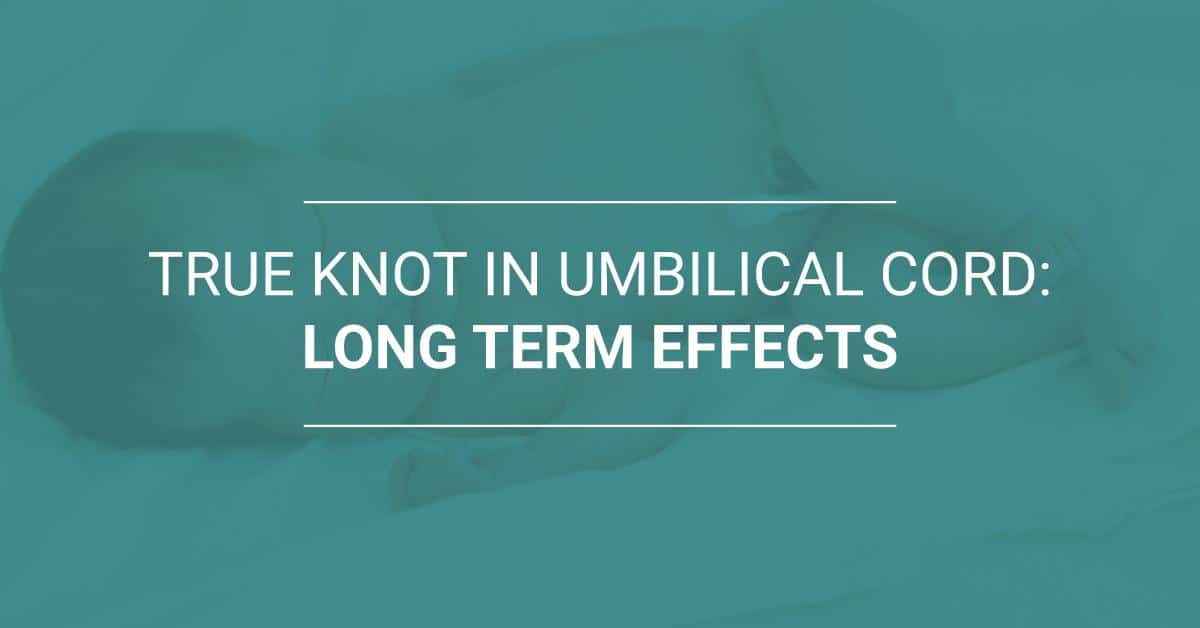
Every pregnant mother hopes that things will go perfectly with her pregnancy, but sadly there are many things that can go wrong during a pregnancy. In most cases, proper monitoring and medical care during pregnancy, labour, and delivery can prevent or reduce the risk of serious complications – and increase the likelihood of a safe, healthy pregnancy and delivery. Unfortunately, there are situations where a doctor fails to diagnose or treat a condition, one such being true knots.
A true knot occurs when the umbilical cord loops around itself during pregnancy as the fetus moves around in the amniotic fluid. When that knot tightens, it can compress the blood vessels in the umbilical cord, cutting off the supply of oxygen-rich blood to the fetus. This can lead to death, or to long-term effects such as cerebral palsy, intellectual impairments, and developmental disorders.
While true knots cannot be prevented, medical professionals can and should monitor for signs of a knot in the umbilical cord. If a true knot is diagnosed, then doctors should be prepared to intervene to reduce the likelihood of death or brain damage. Healthcare providers who fail to do so may be liable for medical negligence.
What Is a True Knot in the Umbilical Cord?
During pregnancy, the umbilical cord is vital to the fetus’ growth and survival. The umbilical cord attaches to the placenta to transfer blood, oxygen and nutrition from mother to baby. It also transfers deoxygenated blood from the fetus into the placenta.
A cord knot is exactly what it sounds like: a place in an umbilical cord that gets tied. A true knot occurs when a cord knot tightens.
While true knots in umbilical cords are relatively rare, they can cause serious complications. A knot in the umbilical cord can cut off nutrients and oxygen to the growing fetus. A true knot can also increase the likelihood of fetal death and brain injury from hypoxic-ischemic encephalopathy (HIE), as blood vessels are compressed when a knot tightens.
There are certain risk factors for umbilical cord knots, including:
- Identical twins
- High levels of amniotic fluid
- Smaller than average baby
- A longer than typical umbilical cord
- Advanced maternal age
- Two or more previous pregnancies
A true knot may be detected by an ultrasound, or through heart rate and activity monitoring. For example, if a fetus’ heart rate is low or inconsistent, that may be a sign of a problem with blood flow to and from the placenta due to a cord knot. If signs of a true knot are present, then a mother may be admitted to the hospital for closer monitoring and to prevent sudden fetal distress. A cesarean section may be necessary.
Contact Us Today
Contact us today to learn more about how our birth injury lawyers have helped families provide for their children and receive peace of mind.
Long-Term Effects of True Knot
While true knots occur in less than 2% of all pregnancies, they carry serious potential complications. Most significantly, a true knot in the umbilical cord is associated with higher rates of intrauterine fetal demise (death). It is also linked to low APGAR scores, preterm deliveries, c-sections, and meconium-stained amniotic fluid.
The long-term effects of a true knot depend on the level of damage caused by the presence of a cord knot. A tighter knot may cause acute hypoxia (lack of oxygen in the tissues), which can lead to infant death. A looser true knot may result in chronic mild hypoxia, or lower levels of oxygen deprivation over time.
Oxygen deprivation, particularly during labour and delivery, can cause complications that are similar to HIE, which occurs when an infant’s brain is deprived of oxygen during the birthing process. The long-term effects of umbilical cord knots may include:
- Cerebral palsy
- Neurological, behavioral, and developmental issues, including Attention Deficit Hyperactivity Disorder (ADHD) and Autism Spectrum Disorder (ASD)
- Sensory issues
- Seizures
Even a relatively mild case of hypoxia linked to a true knot can cause long-term neurodevelopmental challenges. These complications can often be avoided with appropriate monitoring during pregnancy and labour, and medical intervention when necessary to avoid brain damage or even death. A c-section is often the safest way to deliver a baby in this situation.
Failure to monitor as part of antenatal care, particularly in pregnancies that are at high risk for the development of true knots, may be considered medical negligence. Similarly, if medical professionals do not intervene when a true knot is present and there are warning signs of fetal distress, it may be medical negligence.
Talk to a Birth Injury Lawyer Today
When an umbilical cord knot tightens, it can cause serious complications for the baby – including brain damage and death. The long-term effects of a true knot can be devastating, requiring lifelong care and therapies.
If your child has suffered a birth injury related to a true knot in the umbilical cord, you may be entitled to compensation for medical negligence. HIE lawyers at BILA can advocate for you and your family. With offices throughout Canada, we offer highly-skilled, experienced, and compassionate representation for families impacted by true knots.

John McKiggan, QC has represented clients in pediatric and adult injury claims that have resulted in multi-million dollar awards. In recognition of his accomplishments, John has been honoured by his peers, who elected him president of the Atlantic Provinces Trial Lawyers Association. He has also been named Queen’s Counsel, a designation recognizing exceptional professional merit. John has been selected for inclusion in the Best Lawyers in Canada in the field of personal injury law, he is listed in the Canadian Legal Lexpert Directory and has been named a local litigation star by Benchmark Litigation Canada.

